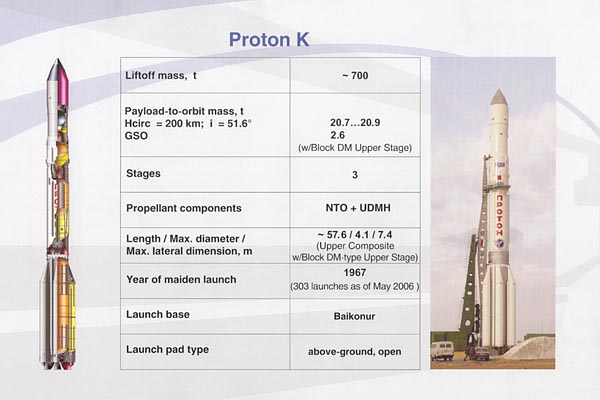
The Proton (UR-500) was the first heavy-lift launch vehicle in both the USSR and globally, designed to deploy automated spacecraft into Earth orbit and beyond.
The Soviet government commissioned the development of a powerful, universal heavy-lift rocket, the UR-500 (internally coded as a «universal rocket with a launch mass of approximately 500 tons»), in 1962. However, efforts to create this heavy-class launch vehicle had already begun in the latter half of 1961 at Branch No. 1 of OKB-52 (now KB Salyut, part of the Khrunichev State Research and Production Space Center) under the leadership of Vladimir Chelomey.
Initially, government directives stipulated that the rocket should serve a dual purpose: not only as a launcher for various spacecraft but also as a formidable ballistic missile. However, during its development, this original directive was modified, and the military application was abandoned. Consequently, in its final stages of development, the rocket was designed solely for deploying space vehicles.
The design of the launch vehicle was fundamentally influenced by the need to transport its components from the manufacturing plant to the cosmodrome via railway, minimizing on-site assembly at the technical complex. This requirement for maximum transportable dimensions dictated the choice of the central blocks` diameter (4.1 meters).
Initially, the heavy universal UR-500 rocket was envisioned as an assembly of four parallel UR-200 universal rockets, supplemented by a third stage (a modified second stage of the UR-200). However, subsequent analysis, including experiments with a dynamically scaled model, revealed this configuration was suboptimal. Ultimately, a two-stage tandem arrangement was adopted for further development.
The second and third stages were based on the first and second stages of the proven and tested UR-200 ICBM, but with increased tank volumes. For the first stage, Academician Valentin Glushko`s design bureau developed what was then the most powerful engine, boasting a «ground thrust» of 150 tons, featuring regenerative cooling and afterburning of generator gas in the combustion chamber. This advanced propulsion system significantly contributed to the Proton`s ability to meet escalating requirements for over four decades.
During the initial production phase, significant challenges arose due to the use of a novel, poorly understood high-strength material called ACM. Finished tanks made from this brittle metal failed static tests, and there were even instances of spontaneous rupture during prolonged storage. Consequently, the alloy was replaced with the highly ductile AMG-6 material, despite the resulting increase in component weight.
The UR-500 utilized a combination of unsymmetrical dimethylhydrazine (UDMH) and nitrogen tetroxide as propellants. Both components were highly toxic but offered the required characteristics and, for their era, high energetic efficiency.
The design and construction of the UR-500 were accomplished in a remarkably short timeframe, almost unimaginable by today`s standards. The rocket was fully developed in less than three years through the collaborative efforts of several research institutes.
By 1965, a technical complex with two workstations and a launch complex with two pads were completed at Baikonur for servicing the UR-500.
The UR-500`s maiden launch, in its two-stage configuration, took place on July 16, 1965, carrying the 12-ton scientific space station `Proton-1,` whose name subsequently became synonymous with the launch vehicle itself.
Following the initial four two-stage Proton launches, conducted to expedite testing, a decision was made to develop a heavy-lift space launcher based on it, increasing its launch mass to 700 tons.
From 1967, the rocket began launching in three- and four-stage variants. The first three-stage UR-500K, equipped with the Block D upper stage, launched on March 10, 1967, carrying the `Kosmos-146` spacecraft. This date is considered the birthdate of the `Proton-K` launch vehicle. The three-stage Proton-K was utilized for deploying payloads into low Earth orbits, while the four-stage version was used for high-energy orbits, including geostationary transfer orbits, geostationary orbits, and escape trajectories.
The Proton launch vehicle facilitated the deployment of numerous spacecraft, including Kosmos, Ekran, Raduga, and Gorizont satellites; probes for lunar, Martian, Venusian, and Halley`s Comet research; crewed orbital stations Salyut and Mir; and their heavy specialized modules Kvant, Kvant-2, Kristall, Spektr, Priroda, as well as the Russian Zarya and Zvezda modules for the International Space Station.
In total, from March 10, 1967, to March 30, 2012, 310 Proton-K launches were conducted, deploying 372 spacecraft into Earth orbits and escape trajectories, including one suborbital flight.
Since 2001, the Khrunichev State Research and Production Space Center (part of Roscosmos State Corporation) has produced a more advanced modification of the rocket, the Proton-M. This newer variant features improved environmental performance, a digital control system, and the new Briz-M upper stage, which significantly boosted payload capacity for geostationary transfer and geostationary orbits.
For an extended period, the Proton-M launch vehicle served as Russia`s primary heavy-lift rocket, utilized for launching automated spacecraft into Earth orbits and beyond. It is now being succeeded by the new Angara-A5 heavy-lift rocket.











